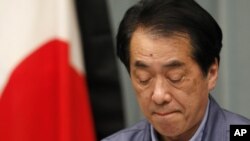Two weeks after a magnitude 9.0 earthquake triggered a huge tsunami that severely damaged a Japanese nuclear power plant, the situation is still not under control.
On Friday evening, the leader of Japan's government shared his pessimism about the current state of the Fukushima 1 nuclear power plant.
Japan's prime minister, Naoto Kan, looking somber in a nationally televised briefing, described the situation at the plant as remaining "very grave and serious."
Vigilance is needed, said Kan, because we have not reached an optimistic point. But he also said things do not appear to be getting worse.
Nuclear engineer Masashi Goto, who resigned his job as a power plant designer over safety concerns, says it is difficult to predict what will happen next at the stricken plant.
Goto points out that events that were considered impossible at Fukushima have already occurred. And he says, while unlikely, more hydrogen explosions among the used fuel rods and excessive heat that can damage container vessels cannot be ruled out.
Steam continued to rise Friday from several reactor buildings at the nuclear facility in northeastern Japan. Work continues to try to bring automated cooling systems back on line that would help prevent an even potentially worse spread of radiation from the severely damaged complex.
Since the March 11 magnitude 9.0 earthquake and resulting tsunami, high radiation levels, fires and explosions at some of the six reactors have slowed efforts to make critical repairs to stabilize the situation.
A high level of radiation detected Thursday in water at the No. 3 reactor's turbine building may have come from the reactor core. Japan's Nuclear and Industrial Safety Agency says there is no data, however, to suggest the reactor vessel has been cracked or damaged.
Concern about the reactor grew after workers laying cable in the turbine building were exposed to water 10,000 times more radioactive than normal levels in the coolant water. Two of the workers were transferred Friday to the National Institute of Radiological Science for treatment of radiation burns on their feet.
Japan's Defense Ministry says pure water and pumps supplied by the United States military will be brought to Fukushima 1 to cool the reactors. It would replace the sea water being used that is causing corrosion because of an accumulation of tons of salt.
Scientists say chloride in the salt could also break open the zirconium alloy layer of protection around the fuel rods which prevents volatile radioactive elements from escaping.
Tokyo Electric Power confirms that zirconium 95 in sea water several hundred meters from the Fukushima plant has been detected since Wednesday when testing began there for additional radioactive elements.
A spokesman for the Japanese prime minister's office tells VOA there is no clear evidence that any fuel rod covering has been breached.
The continuing emission of radioactive vapor has prompted warnings about drinking tap water as far away as 300 kilometers south of the plant. It also has raised safety concerns internationally about Japanese vegetables, milk and seafood.
Japan's government has recommended people living between 20 and 30 kilometers from the facility leave their homes due to dwindling food supplies. Those within 20 kilometers were previously ordered out of the area due to radiation fears.














